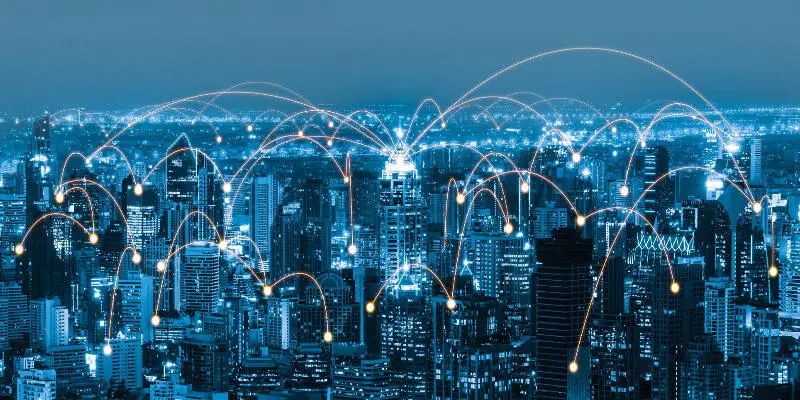Disclaimer: This post may contain affiliate links, meaning we get a small commission if you make a purchase through our links, at no cost to you. For more information, please visit our Disclaimer Page.
If you are trying to connect your electronic device to the internet, there is not one but many ways to do so. All these ways of internet connection use different hardware, hence vary in connection speed and availability.
All of us own at least one or more devices that need an internet connection. Some of these devices are- mobiles, laptops, desktop computers, tablets, e-readers, and voice search gadgets.
With technological advancement, now we have smartwatches, central heating systems, smart televisions, refrigerators, which have advanced functions while connected to the internet. Hence, internet connectivity is no longer a choice but a need of the hour.
We can classify all options providing internet facilities into two broad categories- the first one is an electronic device capable of connecting to the internet facility. The second category is service providers giving you access to the internet to your device.
We can also categorize internet services as either fixed or mobile internet. Fixed internet is specific to a location like home, shop, etc. The mobile internet gives you internet access without any barrier of location.
While choosing the best available option, look for brandwidth, availability, cost, reliability, best ISP, and convenience. Let’s take a closer look at the different ways of connecting to the internet and find out the best one as per our requirement.
Table of Contents
Internet Service Providers
Internet Service Provider (ISP) offers you services like- dial-up access, internet access, leased line access, and domain name registration. It also hosts ISPs and is a mailbox provider.
For apartment dwellers like me, ISP is generally the cable company, which offers TV and internet subscription. But you have to pay for the services you choose, for example, only a TV subscription or internet subscription or both.
ISP links your devices to other servers on the internet. It opens a gateway to the internet and lets you do surfing, online shopping, research, and more
. All homes and organizations with the internet have an ISP. You do not need to share the same ISP to communicate with others.
If you think that anyone with a website and little knowledge about the internet can become an ISP provider, then think again. To become an Internet Service Provider, you need good infrastructure, expert technicians and of course money.
There were three types of ISPs in 1990, broadband, dial-up services, and DSL. By the year 2013, the dial-up services became rare even though they were cheap.
The reason behind the near extinction of dial-up services is the speed which was pretty slow in comparison to other options.
Choose Your Connection Type
There are many ways to connect to the internet. We will now discuss their speed, cost, and limitations to guide you further.
Dial-up Connection
This connection is set up through the telephone lines and connects your computer to the internet. These connections are given by Internet Service Providers.
The traditional telephone lines are used as a method for data transfer for this connection. People who already own a landline connection can establish this connection with a dial-up account and modem.
The data sent by telephone line was of the frequency as voice data for phone calls. Hence, you cannot use your landline for phone calls if you are using the internet.
If you want to use landline and internet both simultaneously then, you need two separate phone lines.
The main requirements for this connection are telephone lines, computer, dial-up modem, dial-up account, and a public access number.
The dial-up account and public access number are given by ISP. The account has a username and password. Users input this number when they need to connect to the internet.
The Dial-up connection service is the first form of internet connectivity. It was used in the beginning phase of the internet era.
The data transfer capacity of this connection is limited, making it slower in comparison to other alternatives. It has a bandwidth of only 56Kbps.
ISDN
Integrated Services Digital Network or ISDN, establishes the connection using the phone lines carrying digital signals.
Both dial-up connection and ISDN use phone lines, but the difference is, the dial-up connection uses the analog signal and ISDN uses digital signals.
In 1988, ISDN was being recommended as a new system for data delivery by the International Telecommunication Union.
This connection gives better signals and faster speed, thus making data transmission more reliable with a speed of 128 Kbps. The cost involved in ISDN is higher than other options, hence, people go for other alternatives. It also requires specialized digital devices.
Basic Rate Interface (BRI) and Primary Rate Interface (PRI) are the two techniques to deliver this service. BRI has a lower cost and gives only basic services. PRI is the main service provider and has faster speed, better connection, and is reliable.
ISDN needs only two seconds to launch a connection whereas, others may take up to 30 -60 seconds. Moreover, you can connect faxes, computers, credit card readers, and other devices to a single line.
DSL
DSL or Digital Subscriber Line is a high-speed internet connection that uses the same wire as used by telephone connection. It started getting popular around the 1980s and 1909s.
It allows users to use the internet and make phone calls at the same time as it separates the telephone signals into three levels of frequencies. The lowest one lets you make phone calls whereas the other two help you in online activities.
The fast speed of DSL is 1.5 Mbps and the top-level speed of this service is 15Mbps. The speed is more than the traditional setup, but it is not the best when you want to use the internet for a long duration.
There are many versions of DSL today- Asymmetrical DSL, Symmetric DSL, Rate adaptive VSL, High bit-rate DSL, Very high bit-rate DSL, and ISDN DSL. The main difference among them is speed and service.
With this connection, there is no need for new wiring and you can keep the connection open always while making voice calls. But DSL services are not available everywhere and are generally concentrated in the areas near the service provider’s office.
Cable TV Internet Connection
It is a form of internet connection done through cable TV lines rather than telephone lines. A cable TV internet connection is used to connect a computer or a local network to the internet.
This connection was first introduced in 1997-98 in the US and allowed users to connect their computers to the internet at high speed. The speed of data transfer is high as it uses coaxial cable, which gives a speed ranging from 512K to 2o Mbps.
The speed may vary depending on whether you are uploading data or downloading it.
It uses a cable modem, provided by the operator to access the internet service. The modem has two connections- one for cable TV and the other for internet access.
The data transfer speed is slow during peak hours as the cable internet works with the lines connected to the television. Moreover, if you have a cable TV connection, it does not give you a surety of cable internet connection. This connection is not available in remote and rural areas.
Satellite Internet Connection
This connection uses radio waves to communicate with satellites moving around Erath. Data is sent from your device through modem and satellite dish, to the satellite out in space.
It then returns to Earth to the network operations centers (NOC). Again the data travels through the same route, out to satellite and then to your device.
It uses a five-part relay system- device, modem or router, satellite dish, space satellite, and NOC (Network Operations Centre). Two types of satellite connections are- one-way connection and two-way connection.
You can easily download data in one way connection. If you need to upload, then dialup access is required. You can get it through ISP over a telephone line. In a two-way connection, there is no need for a dial-up connection. You can easily download and upload data by satellite.
This internet connection is especially beneficial to the areas which lack broadband connectivity. It is nearly ten to thirty-five times faster than dialup connections and can handle high bandwidth usage. The satellite internet connection speed is from 512 K to 2 Mbps.
During bad weather or rain, you should expect poor or no signals. Even minor issues can affect your signal quality, for example, the direction of your satellite dish.
Satellite internet is one of the expensive ways to connect your devices to the internet. It also has a high ping rate or poor latency. It means that it takes a bit of time to communicate between devices. The signals have to travel lots of distance from your device to satellite and then back to Earth.
The latest Starlink internet satellite project plans to bring fast internet at an affordable price to those parts of the world where the internet is not currently available. The test download speed of this connection is 103 Mbps and has a latency average of 39 ms.
Fiber Internet Connection
The fiber internet uses fiber optic cable, capable of sending data at the 70% speed of light. This connection has a maximum speed of 940 Mbps (Megabits per second).
These cables are strong enough to face weather conditions, unlike other traditional cables. They are also resistant to electrical interference.
In case you have several devices with multiple users, fiber is an ideal internet option for you.
The optic fiber is a tiny bit larger than a human hair. An optic cable is made by combining these fibers. They are not like coaxial cables, which are of copper.
These fibers carry laser pulses and transmit information in binary form. They use light to deliver signals through a core made of fiberglass.
Wireless Internet Connection
Wireless Internet Connection uses radio frequency to connect your device to the internet and offers high speed. This connection can be set up by either Bluetooth or WiFi.
In this connection, radio frequency bands are used instead of cable or telephone networks. You can always have the internet on with this connectivity. You can easily access it from locations falling under network coverage.
The modem picks up internet signals and sends them to other devices. The speed of this connection varies from 5Mbps to 20 Mbps.
The WiFi wireless internet technology is based on 802.11 standards. It allows devices to connect to the internet.
Bluetooth technology uses short-wavelength radio waves thus, creating a Personal Area Network. Hotspot also uses wireless technology to connect devices to the internet by wireless local area network. It can be phone-based, commercial, or free.
Wireless connections are easy to set, expand, provide mobility and convenience at a lower cost. The main disadvantages of this system are security, range, and speed.
Most of the wireless networks have a speed of 1 to 54 Mbps. The average range of the network is suitable for home or small offices but not for large compounds.
Broadband
It is a high-speed permanent internet connection that uses multiple data channels to send and receive large quantities of information. This setting has a wide range of frequencies and brings signals through traditional telephone lines.
The dial-up connection also uses phone lines, but there is variation in speed. You can get a speed between 11Mbps to 50 Mbps through broadband. For home broadband lines copper and fiber are the most commonly used options.
In this connection, your phone line is free to be used while you are using the internet. Online games can be played, through this connection. It gives you unlimited access to the internet and no charges are levied for your internet usage duration.
No need to dial the access number for starting up your internet service every time you use it. Broadband also gives you the advantage of low-cost phone services.
This type of connection has a high-security risk, so you need firewall protection for your devices. There is a high monthly fee involved with this connection as compared to dial-up.
Mobile Internet
Mobile phone operators provide internet access through cell phones. You can get this service either on a contract basis or pay as you go basis. Many plans are available for mobile users that offer voice plans and internet packages and have varying price ranges.
The speed of your internet connection varies with your service provider and plan. The most common speeds are 3G and 4G. The term 3G refers to a third-generation cellular network with a speed of 2 Mbps. The fourth generation of cellular wireless standard or 4G has a speed range from 100 Mbps to 21 Mbps.
The mobile internet connection may go slow in certain areas. Another disadvantage is that you will shell out extra money for data that you may not be using. Hence, be careful about the plan you choose.
Type Of Internet Connection You Need For Your Home
Your home internet connection depends on your family’s browsing habits. Moreover, keep in mind which internet options are available in your area. Do crosscheck their speed and cost also before coming to any decision.
The options for home internet are DSL, cable, fixed wireless, satellite, and fiber. If you want to check emails, do some web surfing, and online shopping by using more than three devices, you need a speed of 10 to 25 Mbps.
You can get this speed through cable, DSL, fixed wireless, and satellite internet connection.
If you are the only one in your family who is an online gaming fan, your requirement is 10 to 25 Mbps. This requirement is fulfilled by cable, fiber, DSL, and fixed wireless.
If there are more than three devices connected to the internet for internet gaming, the speed required will be more than 25Mbps. Then you need to choose from a DSL, cable, or fiber connection.
For streaming video in HD, you need 10 to 50 Mbps. This speed can be provided by cable, fiber, fixed wireless, and DSL. If you are working from home, the requirement of the internet speed may vary because of the number of online meetings or downloads. The normal speed required is 40 Mbps, which you can get only through cable or fiber.
A satellite internet connection gives adequate speed for gaming but has high latency, which prevents you from having a worthy gaming experience.
Fibre internet and cable internet connections can help you perform nearly all online activities. Satellite or DSL can be a higher value option if you are an occasional user of the internet.
The best internet connection for your home depends on the number of connected devices in the household, online activities undertaken, and the reliability and cost of the service provider.
Choosing Internet Connection For Your Business
You have plenty of options for your business also if you are looking for internet connectivity. Your choice may vary depending on your service and speed requirements and the cost involved.
Some of the popular ones are DSL, satellite internet, cable internet, and fiber connection.
Your choice of internet connection depends on your business demands. If you are looking for light fastening speed go for a fiber internet connection.
If you have a low budget then DSL is the right option for you. If your business is in a remote area, then a satellite internet connection is the answer to your internet problems.
Conclusion
We need the internet to connect our ever-increasing range of electronic gadgets to the online world. There are plenty of ways to access the internet and which alternative you choose depends on several factors.
You have to consider your lifestyle, how frequently you need the internet, the types of things you seek to do, and your budget.
If you are a big Netflix fan, then you need at least 3 Mbps for standard definition. As per Netflix recommendations, you should have 5Mbps for HD and 25 Mbps for Ultra HD quality. If you need the internet for other online activities then you need more speed.
If a student is looking for videos as a part of project work, then 50 Mbps is the recommended speed. If it is not just a single person using the internet for downloading but others are also active net users, then speed goes up to 100 Mbps.
For a person working from home, 10 Mbps download and 1 Mbps upload speed is required. Therefore, the type of internet connection you choose depends on whether you are at home or out, the number of hours you need access to the internet, the online activities you are involved in, and the charges involved.



